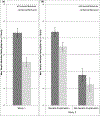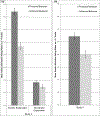Asymmetrical genetic attributions for prosocial versus antisocial behaviour
- PMID: 31358975
- PMCID: PMC6744345
- DOI: 10.1038/s41562-019-0651-1
Asymmetrical genetic attributions for prosocial versus antisocial behaviour
Abstract
Genetic explanations of human behaviour are increasingly common. While genetic attributions for behaviour are often considered relevant for assessing blameworthiness, it has not yet been established whether judgements about blameworthiness can themselves impact genetic attributions. Across six studies, participants read about individuals engaging in prosocial or antisocial behaviour, and rated the extent to which they believed that genetics played a role in causing the behaviour. Antisocial behaviour was consistently rated as less genetically influenced than prosocial behaviour. This was true regardless of whether genetic explanations were explicitly provided or refuted. Mediation analyses suggested that this asymmetry may stem from people's motivating desire to hold wrongdoers responsible for their actions. These findings suggest that those who seek to study or make use of genetic explanations' influence on evaluations of, for example, antisocial behaviour should consider whether such explanations are accepted in the first place, given the possibility of motivated causal reasoning.
Conflict of interest statement
Figures




Similar articles
-
Asymmetric Causal Attributions to Environmental Influences for Prosocial Versus Antisocial Behavior.Soc Cogn. 2023 Jun;41(3):303-315. doi: 10.1521/soco.2023.41.3.303. Soc Cogn. 2023. PMID: 37701647 Free PMC article.
-
Asymmetric genetic attributions for one's own prosocial versus antisocial behavior.J Soc Psychol. 2024 May 3;164(3):273-279. doi: 10.1080/00224545.2022.2058906. Epub 2022 Mar 31. J Soc Psychol. 2024. PMID: 35358028 Free PMC article.
-
Susceptibility to prosocial and antisocial influence in adolescence.J Adolesc. 2020 Oct;84:56-68. doi: 10.1016/j.adolescence.2020.07.012. Epub 2020 Aug 25. J Adolesc. 2020. PMID: 32858504 Free PMC article.
-
The effects of temperature on prosocial and antisocial behaviour: A review and meta-analysis.Br J Soc Psychol. 2023 Jul;62(3):1177-1214. doi: 10.1111/bjso.12626. Epub 2023 Feb 16. Br J Soc Psychol. 2023. PMID: 36794795 Review.
-
Predictors of antisocial behaviour in children with attention deficit hyperactivity disorder.Eur Child Adolesc Psychiatry. 2006 Mar;15(2):118-25. doi: 10.1007/s00787-006-0511-1. Eur Child Adolesc Psychiatry. 2006. PMID: 16523253 Review.
Cited by
-
A 30-nation investigation of lay heritability beliefs.Public Underst Sci. 2024 Nov;33(8):940-960. doi: 10.1177/09636625241245030. Epub 2024 Apr 25. Public Underst Sci. 2024. PMID: 38664920 Free PMC article.
-
Genetic essentialist beliefs about criminality predict harshness of recommended punishment.J Exp Psychol Gen. 2022 Dec;151(12):3230-3248. doi: 10.1037/xge0001240. Epub 2022 Jun 27. J Exp Psychol Gen. 2022. PMID: 35758988 Free PMC article.
-
Asymmetric Causal Attributions to Environmental Influences for Prosocial Versus Antisocial Behavior.Soc Cogn. 2023 Jun;41(3):303-315. doi: 10.1521/soco.2023.41.3.303. Soc Cogn. 2023. PMID: 37701647 Free PMC article.
-
Asymmetric genetic attributions for one's own prosocial versus antisocial behavior.J Soc Psychol. 2024 May 3;164(3):273-279. doi: 10.1080/00224545.2022.2058906. Epub 2022 Mar 31. J Soc Psychol. 2024. PMID: 35358028 Free PMC article.
-
Asymmetrical genetic attributions for the presence and absence of health problems.Psychol Health. 2024 Jul;39(7):839-857. doi: 10.1080/08870446.2022.2119236. Epub 2022 Sep 6. Psychol Health. 2024. PMID: 36067389 Free PMC article. Clinical Trial.
References
-
- Haslam N & Kvaale EP Biogenetic explanations of mental disorder: The mixed-blessings model. Current Directions in Psychological Science 24, 399–404 (2015).
-
- Hoyt CL, Burnette JL, Auster-Gussman L, Blodorn A & Major B The obesity stigma asymmetry model: The indirect and divergent effects of blame and changeability beliefs on antifat prejudice. Stigma and Health 2, 53–65 (2017).
Publication types
MeSH terms
Grants and funding
LinkOut - more resources
Full Text Sources

